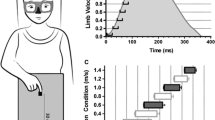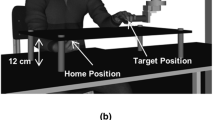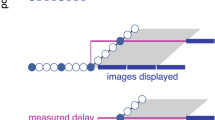Abstract
Online visual control of the direction of rapid reaching movements was assessed by evaluating how human subjects reacted to shifts in seen hand position near movement onsets. Participants (N=10) produced saccadic eye and rapid arm movements (mean duration = 328 ms) towards a peripheral visual target in complete darkness. During the saccade, visual feedback of hand position could be shifted by 1, 2, 3 or 4 cm perpendicularly to the main movement direction. The resulting discrepancies between visual and proprioceptive information about hand position were never consciously perceived by the subjects. Following the shifts, hand trajectories deviated from those produced in a control condition (without shift) in order to bring seen hand position closer to the target. Globally, the deviations corresponded to 45% of the shifts, regardless of their magnitude or movement duration. This finding highlights not only the efficiency of visual feedback processing in online motor control but also underlines the significant contribution of limb proprioception.



Similar content being viewed by others
References
Abahnini K, Proteau L (1999) The role of peripheral and central visual information for the directional control of manual aiming movements. Can J Psychol 53:160–175
Bard C, Hay L, Fleury M (1985) Role of peripheral vision in the directional control of rapid aiming movements. Can J Psychol 39:151–161
Bédard P, Proteau L (2001) On the role of static and dynamic visual afferent information in goal-directed aiming movements. Exp Brain Res 138:419–431
Blouin J, Bard C, Teasdale N, Fleury M (1993a) On-line versus off-line control of rapid aiming movements. J Mot Behav 25:275–279
Blouin J, Teasdale N, Bard C, Fleury M (1993b) Directional control of rapid arm movements: the role of the kinetic visual feedback system. Can J Exp Psychol 47:678–696
Bridgeman B, Vanderheijden AHC, Velichkovsky BM (1994) A theory of visual stability across saccadic eye movements. Behav Brain Sci 17:247–258
Clower DM, Boussaoud D (2000) Selective use of perceptual recalibration versus visuomotor skill acquisition. J Neurophysiol 84:2703–2708
Lhuisset L, Proteau L (2002) Developmental aspects of the control of manual aiming movements in aligned and non-aligned visual displays. Exp Brain Res 146:293–306
Paillard J (1996) Fast and slow feedback loops for the visual correction of spatial errors in a pointing task: a reappraisal. Can J Physiol Pharmacol 74:401–417
Plooy A, Tresilian JR, Mon-Williams M, Wann JP (1998) The contribution of vision and proprioception to judgements of finger proximity. Exp Brain Res 118:415–420
Prablanc C, Martin O (1992) Automatic control during hand reaching at undetected two-dimensional target displacements. J Neurophysiol 67:455–469
Sarlegna F, Blouin J, Bresciani J-P, Bourdin C, Vercher J-L, Gauthier GM (2003) Target and hand position information in the online control of goal-directed arm movement. Exp Brain Res 151:524–535
van Beers RJ, Wolpert DM, Haggard P (2002) When feeling is more important than seeing in sensorimotor adaptation. Curr Biol 12:834–837
Vercher J-L, Magenes G, Prablanc C, Gauthier GM (1994) Eye-head-hand coordination in pointing at visual targets: spatial and temporal analysis. Exp Brain Res 99:507–523
Acknowledgements
This work received financial support from the CNRS (Program ROBEA) and the Université de la Méditerranée. We thank Alain Donneaud for technical assistance and Marcel Kaszap and Thelma Coyle for programming expertise. We also thank Luc Proteau and an anonymous reviewer for numerous comments made on an earlier version of this paper.
Author information
Authors and Affiliations
Corresponding author
Rights and permissions
About this article
Cite this article
Sarlegna, F., Blouin, J., Vercher, JL. et al. Online control of the direction of rapid reaching movements. Exp Brain Res 157, 468–471 (2004). https://doi.org/10.1007/s00221-004-1860-y
Received:
Accepted:
Published:
Issue Date:
DOI: https://doi.org/10.1007/s00221-004-1860-y




